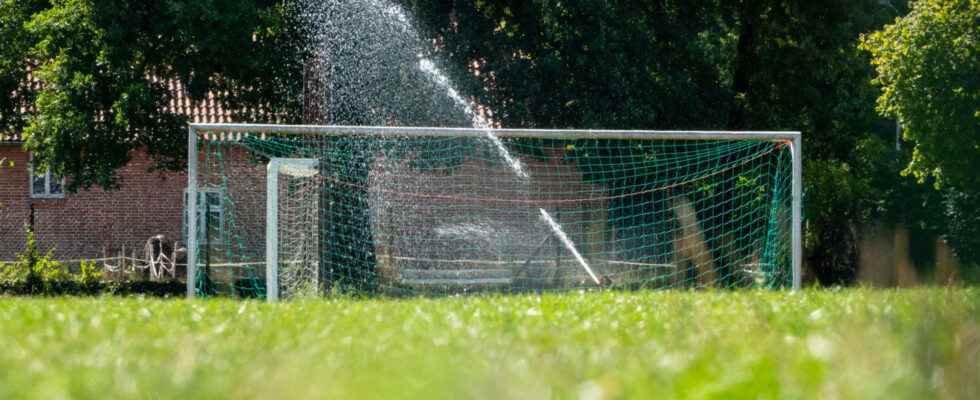The rectangle is no longer so green: the historic drought in France is weakening football pitches and forcing clubs to regulate the watering of their lawns. The sector is trying to adapt. During the first day of Ligue 1, last weekend, the large brown spots visible on the lawn of the Stade de la Mosson, in Montpellier, challenged observers, accustomed in recent years to the perfect lawns of the French Championship, very telegenic.
Proliferation of an unwanted fungus
Before the second day of Ligue 1, the Lorient club is also worried about its ground, damaged by the drought and the interceltic festival. Le Moustoir must be inspected Thursday and Friday by the authorities before the reception of Lyon on Sunday (1:00 p.m.). In the Hérault, it is a fungus which is in question, the pyricularia, which has also appeared in recent weeks elsewhere in France, such as at the Aube stage in Troyes.
“It’s a fungus that proliferates particularly in periods of high heat, but at the moment, the temperature in the heart of the field can rise up to 50 degrees”, explains David Garnerin, in charge of sports at the Troyes Champagne Métropole agglomeration ( TCM), which manages stadium maintenance.
“Everything was there: a young lawn that needs to be watered a lot, temperatures that don’t drop at night, a heat that lasts. Whereas last summer, which was much less hot, there were no problems”, continues Bertrand Yot, head of landscaping areas for the agglomeration, who manages the stadium gardeners. In Montpellier, the metropolis has recognized that the heat wave and drought conditions “make (have) difficult the eradication of the undesirable fungus”.
“You have to find the right balance”
At the same time, the clubs have to deal with water restrictions decided by prefectural decree in many areas of the country, placed on drought alert at different levels. If the watering of green spaces or the filling of private swimming pools is prohibited in the event of a drought alert, football, like other outdoor sports, benefits from an exemption, with, most often, a strict limitation of watering schedules, prohibited in the middle of the day.
But “a lawn that lacks water will develop less, will turn yellow, brown, will absorb changes in direction less and will be much more heterogeneous”, notes Sébastien Cottat, business manager for the Sparfel group, which equips and maintains several pitches. of professional clubs. “For the moment, we are holding on. In Brest or Caen, there is not too much problem with watering only at night. We suffer a lot more on Corsica”, continues the specialist, who recognizes that these restrictions prevent to embark on any regeneration of land, because “young seedlings require a lot of water”.
“You have to find the right balance, because the land is the working tool”, underlines Baptiste Malherbe, general manager of AJ Auxerre, which pumps its water in neighboring Yonne. “But we are careful, we limit (watering) as much as possible”.
“It’s probably only the beginning”
Suppliers, gardeners, players in the game and sports bodies have nevertheless integrated these issues into the sector. Hybrid lawns, currently widely used in professional football, thus offer “substrates with high water retention capacity”, pleads Bertrand Yot, from the Troyes conurbation. At the Aube stadium, annual water consumption thus reached 3,000 m³ in 2018. By way of comparison, that of a nine-hole golf course is estimated at 25,000 m3 by the French Golf Federation.
Some clubs, such as Marseille and Lille, also use rainwater recovery systems in their stadiums, which Rennes intends to set up in its future training center. And faced with the drought, the Professional Football League suspended its lawn championship rewarding the best lawn in Ligue 1, calling for “the most reasoned watering possible” which maintains a “minimum quality of the lawn”.
Sustainable measures? Professionals in the sector do not hide their faces: “certainly, this summer is exceptional, but we know that this is probably only the beginning”, recognizes Sébastien Cottat.
